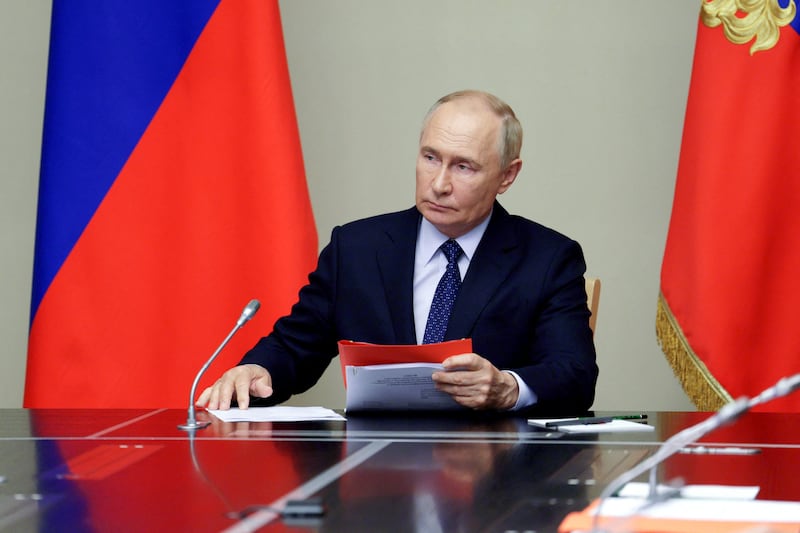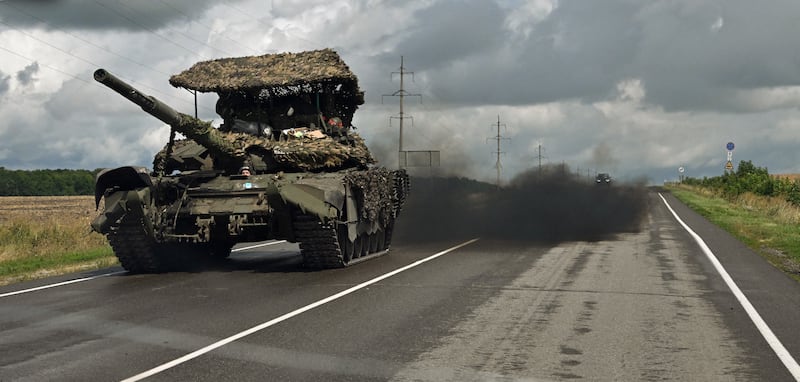Russia was fighting intense battles on Saturday against thousands of Ukrainian troops as deep as 20km inside the Kursk region after Ukraine’s biggest attack on Russian sovereign territory since the start of the war in 2022.
Ukrainian forces rammed through the Russian border early on Tuesday and swept across some western parts of Russia’s Kursk region, a surprise attack that may be aimed at gaining leverage in possible ceasefire talks after the US election.
Supported by swarms of drones and heavy artillery fire, Ukrainian units moved quickly to carve out a sliver of the western Russian territory beside the border while sabotage units pierced deeper inside Russia, according to Russian war bloggers.
More than 76,000 people have been evacuated from areas bordering Ukraine in the region, the local emergency ministry was quoted by the Tass news agency as saying on Saturday.
“The armed forces continue to repel the attempted invasion by the Ukrainian armed forces,” Russia’s defence ministry said on Saturday, adding that intense battles were focused around Malaya Loknya, Olgovka and Ivashkovskoye, settlements around 10-20km inside Russia.
In a sign of the gravity of the situation, Russia imposed a sweeping security regime in three border regions on Saturday while Belarus said it had repelled what it thinks was a major drone attack from Ukraine.

President Vladimir Putin cast the Ukrainian attack as a major provocation and though Russia’s top general, Valery Gerasimov, said on Wednesday that Ukraine’s incursion had been halted, Russia has thus far failed to push the Ukrainian forces back over the border.
Meanwhile, Ukraine’s president Volodymyr Zelenskiy acknowledged for the first time on Saturday that his country’s forces were fighting in the Kursk region and said the operation was part of Kyiv’s drive to restore justice after Russia’s 2022 invasion.
Mr Zelenskiy had previously stayed silent about the operation.
In his nightly video address, he said he had discussed the operation with top Ukrainian commander Oleksandr Syrskyi, while not forgetting the battles troops face on the difficult eastern front.
“Today, I received several reports from commander-in-chief Syrskyi regarding the front lines and our actions to push the war on to the aggressor’s territory,” he said.
“I am grateful to every unit of the defence forces for ensuring that. Ukraine is proving that it can indeed restore justice and ensure the necessary pressure on the aggressor.”
Mr Zelenskiy had previously alluded to the operation, praising the military’s ability “to surprise” and thanking them for taking Russian soldiers prisoner to be used in future negotiations, specifically referring to the past week.
In paying tribute to Ukrainian forces along the 1,000lm-front line, Mr Zelenskiy made special mention of actions in northern Sumy region, across the border from Russia’s Kursk region.
Russian military bloggers said on Saturday the situation had stabilised after Russia rushed in forces to halt the surprise advance, though they said Ukraine was swiftly building up forces.
The Ukrainian attack has prompted some in Moscow to question why Ukraine was able to pierce the Kursk region so easily after more than two years of the most intense land war in Europe since the second World War.
“A full scale military operation is under way against a very serious enemy who are certainly not idiots,” said Yuri Podolyaka, a popular Ukrainian-born, pro-Russian military blogger. He said that Russian aviation had saved the day by pummeling scores of invading Ukrainian units, but also said the truth should be told about the gravity of the situation.

The battles around Sudzha come at a crucial juncture in the war: Kyiv is concerned that US support could weaken if Republican Donald Trump wins the November presidential election.
Mr Trump has said he would end the war, and both Russia and Ukraine are keen to gain the strongest possible bargaining position on the battlefield.
Ukraine wants to pin down Russian forces, which control 18 per cent of its territory, while showing the West that it can still muster major military operations that hurt Russia even if the Kursk front is unlikely to change the outcome of the war.
Ukraine has not commented directly on the attack but video posted on Ukrainian media purported to show Ukrainian soldiers in control of a gas measuring facility in the border town of Sudzha, where Russian natural gas flows into Ukraine for transit to Europe.
Reuters could not verify the video. Reports from Russian sources said Ukraine was in control of some areas of Sudzha. Gas was still flowing through the pipeline on Saturday.

Alexander Bortnikov, the director of the Federal Security Service (FSB), ordered an antiterrorist regime be imposed on Kursk, Bryansk and Belgorod regions which have a combined area of nearly 92,000 sq km.
The measures essentially give the security services sweeping powers to lockdown an area, including controls on communications and limits on a host of usual freedoms. Thousands of civilians have been evacuated from Kursk region.
Some reports said Ukrainian forces were pushing towards the Kursk nuclear power station, which supplies a major chunk of southern Russia’s electricity. It has a total six reactors, two shutdown, two under construction and two operational.
The acting governor of Kursk region, Alexei Smirnov, said drone debris had fallen on a power substation near Kurchatov, the town which serves the Kursk nuclear station, which said it was operating as normal on Saturday.
The head of the United Nation’s International Atomic Energy Agency noted the “significant military activity” in the area and called for restraint.
Russian diplomats in Vienna told the IAEA that fragments, possibly from downed missiles, had been found, though there was no evidence of an attack on the station. – Reuters














